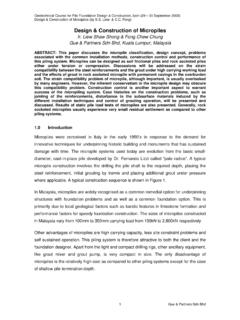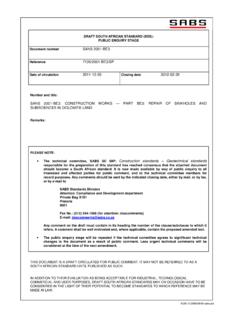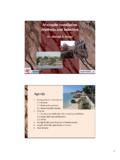Transcription of Design & Construction of Micropiles - Crocker Ltd Historic ...
1 geotechnical Course for Pile Foundation Design & Construction , Ipoh (29 30 September 2003) Design & Construction of Micropiles (by Liew & Fong) Gue & Partners Sdn Bhd 1 Design & Construction of Micropiles Ir. Liew Shaw Shong & Fong Chew Chung Gue & Partners Sdn Bhd, Kuala Lumpur, Malaysia ABSTRACT: This paper discusses the micropile classification, Design concept, problems associated with the common installation methods, Construction control and performance of this piling system. Micropiles can be designed as soil frictional piles and rock socketed piles either under tension or compression. Discussions will be addressed on the strain compatibility between the steel reinforcements and the grout under high carrying working load and the effects of grout in rock socketed micropile with permanent casings in the overburden soil. The strain compatibility problem of micropile, although important, is usually overlooked by many engineers.
2 However, the inherent conservatism in the micropile Design may obscure this compatibility problem. Construction control is another important aspect to warrant success of the micropiling system. Case histories on the Construction problems, such as jointing of the reinforcements, disturbance to the subsurface materials induced by the different installation techniques and control of grouting operation, will be presented and discussed. Results of static pile load tests of Micropiles are also presented. Generally, rock socketed Micropiles usually experience very small residual settlement as compared to other piling systems. Introduction Micropiles were conceived in Italy in the early 1950 s in response to the demand for innovative techniques for underpinning Historic building and monuments that has sustained damage with time. The micropile systems used today are evolution from the basic small-diameter, cast-in-place pile developed by Dr.
3 Fernando Lizzi called palo radice . A typical micropile Construction involves the drilling the pile shaft to the required depth, placing the steel reinforcement, initial grouting by tremie and placing additional grout under pressure where applicable. A typical Construction sequence is shown in Figure 1. In Malaysia, Micropiles are widely recognised as a common remedial option for underpinning structures with foundation problems and as well as a common foundation option. This is primarily due to local geological factors such as karstic features in limestone formation and performance factors for speedy foundation Construction . The sizes of Micropiles constructed in Malaysia vary from 100mm to 350mm carrying load from 150kN to 2,800kN respectively Other advantages of Micropiles are high carrying capacity, less site constraint problems and self sustained operation. This piling system is therefore attractive to both the client and the foundation designer.
4 Apart from the light and compact drilling rigs, other ancillary equipment, like grout mixer and grout pump, is very compact in size. The only disadvantage of Micropiles is the relatively high cost as compared to other piling systems except for the case of shallow pile termination depth. geotechnical Course for Pile Foundation Design & Construction , Ipoh (29 30 September 2003) Design & Construction of Micropiles (by Liew & Fong) Gue & Partners Sdn Bhd 2 Figure 1: Typical Micropile Construction SequenceGeotechnical Course for Pile Foundation Design & Construction , Ipoh (29 30 September 2003) Design & Construction of Micropiles (by Liew & Fong) Gue & Partners Sdn Bhd TYPES OF Micropiles AND DRILLING METHODS Micropile Classification Micropiles are generally classified firstly according to Design application and grouting method. The Design application dictates the function of the micropile while the grouting method defines the grout/grout bond capacity.
5 In the Design application, there are two general types of application. The first type is where the micropile is directly loaded either axially or laterally and the pile reinforcement resists the majority of the applied load. Examples of such application are shown in Figure 2. This type of pile is used to transfer structural loads to deeper, more competent or stable stratum and may be used to restrict the movement of the failure plane in slopes. The loads are primarily resisted by the steel reinforcement structurally and by the grout/grout bond zone geotechnically. Figure 2: Directly Loaded Micropiles Examples Second type of Design application is where the micropile reinforces the soil to make a reinforced soil composite that resist the applied load and known as reticulated pile network. Examples are shown in Figure 3. This application of micropile serves to circumscribe and internally strengthen the reinforced soil composite.
6 The method of grouting is generally the most sensitive Construction control over grout/ground bond capacity and varies directly with the grouting method. The second part of the micropile classification is based primarily on the method of placement and pressure under which grouting is used during Construction . The classification is shown schematically in Figure 4. geotechnical Course for Pile Foundation Design & Construction , Ipoh (29 30 September 2003) Design & Construction of Micropiles (by Liew & Fong) Gue & Partners Sdn Bhd 4 Figure 3: Reticulated Pile Network Micropiles Examples Type A: Type A classification indicates that grout is placed under gravity head only. Sand-cement mortars, as well as neat cement grouts, can be used because the grout column is not pressurised. Type B: Type B indicates that neat cement grout is placed into the hole under pressure as the temporary steel drill casing is withdrawn. Injection pressures typically range from to 1 MPa, and are limited to avoid hydro-fracturing the surrounding ground or causing excessive grout takes, and to maintain a seal around the casing during its withdrawal, where possible.
7 Type C: Type C indicates a two-step process of grouting: Primary grout is placed under pressure of MPa, causing hydrofracturing of surrounding ground. Prior to the hardening of the primary grout (typically 15 to 25minutes), secondary grout is injected usually via tube manchette. This method is sometimes referred to as IGU (Injection Globale et Unitaire) geotechnical Course for Pile Foundation Design & Construction , Ipoh (29 30 September 2003) Design & Construction of Micropiles (by Liew & Fong) Gue & Partners Sdn Bhd 5 Figure 4: Micropile Classification based on Grouting Method Type D: Type D indicates a two-step process of grouting similar to Type C with modifications to the secondary grouting. Primary grout is placed under pressure and after hardening of the initially placed grout, additional grout is injected via tube manchette at a pressure of 2 to 8 MPa. A packer may be so that specific levels can be treated several times, if required.
8 Drilling Techniques The drilling method is selected on the basis of causing minimal disturbance to the ground and nearby sensitive structures and able to achieve the required drilling performance. In all drilling methods, drilling fluid is used as a coolant for the drill bit and as a flushing medium to remove the drill cuttings. Water is the most common drilling fluid compared to other drilling geotechnical Course for Pile Foundation Design & Construction , Ipoh (29 30 September 2003) Design & Construction of Micropiles (by Liew & Fong) Gue & Partners Sdn Bhd 6fluid such as drill slurries, polymer, foam and bentonite. Another type of flushing medium is using compressed air, which is commonly used in Malaysia. Generally, there are six main drilling techniques and their principles and range of application are shown in Table 1. Single-tube advancement - external flush (wash boring): By this method, the toe of the drill casing is fitted with an open crown or bit, and the casing is advanced into the ground by rotation of the drill head.
9 Water flush is pumped continuously through the casing, which washes debris out and away from the crown. The water-borne debris typically escapes to the surface around the outside of the casing, but may be lost into especially loose and permeable upper horizons. Care must be exercised below sensitive structures in order that uncontrolled washing does not damage the structure by causing cavitation. Air flush is not normally used with this system due to the danger of accidentally over pressurizing the ground in an uncontrolled manner, which can cause ground disturbance. Conversely, experience has shown that polymer drill flush additives can be very advantageous in certain ground conditions, in place of water alone. These do not appear to detrimentally affect grout-to-soil bond development as may be the case with bentonite slurries. Rotary Duplex: With the rotary duplex technique, drill rod with a suitable drill bit is placed inside the drill casing.
10 It is attached to the same rotary head as the casing, allowing simultaneous rotation and advancement of the combined drill and casing string. The flushing fluid, usually water or polymer flush, is pumped through the head down through the central drill rod to exit from the flushing ports of the drill bit. The flush-borne debris from the drilling then rises to the surface along the annulus between the drill rod and the casing. At the surface, the flush exits through ports in the drill head. Although any danger with duplex drilling is less than when using the single-tube-method, air flush must be used with caution because blockages within the annulus can allow high air pressures and volumes to develop at the drill bit and cause ground disturbance. Rotary Percussive Duplex (Concentric): Rotary percussive duplex systems are a development of rotary duplex methods, whereby the drill rods and casings are simultaneously percussed, rotated, and advanced.







